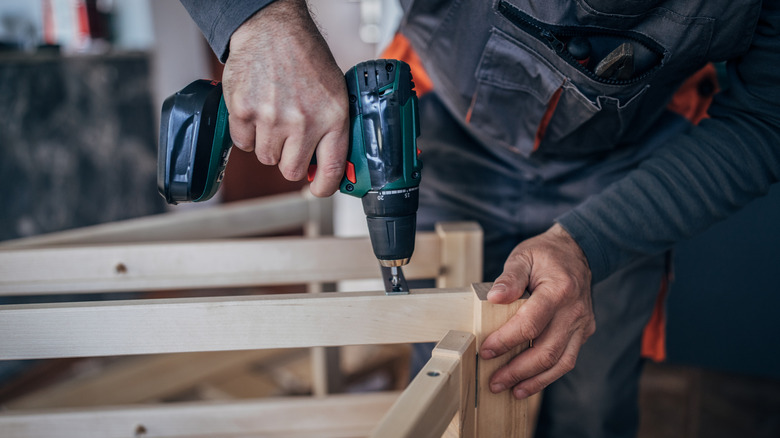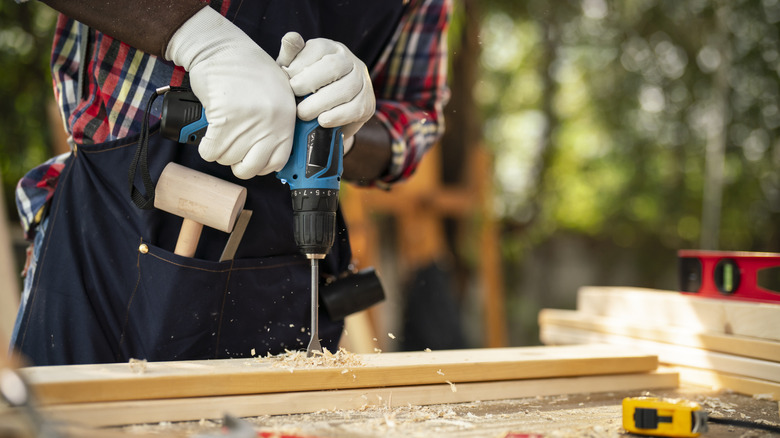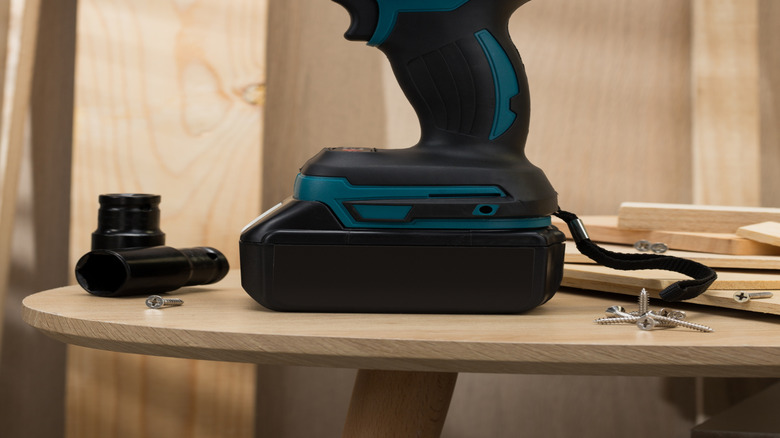Mistakes Everyone Makes When Using A Cordless Drill Around The House
Cordless drills make so many day-to-day tasks simpler. You don't even need to get one of the most powerful cordless drills from a given brand to significantly reduce the amount of time you spend on a given project (although it certainly couldn't hurt).
The convenience of this power tool speaks for itself — it can do everything a regular power drill can, without limiting you to working next to an outlet, and you don't have to worry about tripping over any pesky cords. However, even though working with this machine seems simple enough, many folks inadvertently make DIY tasks so much harder on themselves by failing to follow essential steps.
Numerous cordless drill mistakes can ruin your day. Best case scenario: It'll simply delay whatever you were hoping to work on for the day. But at worst, you could severely injure yourself and others. It's critical to be mindful of the following errors that even professionals make from time to time. Whether it's your first time working with a power drill or you've used one for years, it never hurts to get these helpful reminders.
Not planning ahead
When you have a corded drill, it's easy enough to plug it in and get to work. When you have a cordless one, you need to plan ahead a little bit. You never want to trust your drill is still pretty much charged from the last time you used it. When in doubt, charge it up at least a few hours before you start working on your project. Otherwise, you might wind up having to delay it until the battery has some juice. You may also simply feel like using it while it's plugged in, but that sort of defeats the purpose of the tool being cordless, doesn't it?
If you're the kind of person who starts projects on a whim, and you don't use your drill all that often, it's prudent to charge it before putting it away. Another good idea is to have a spare battery handy that's charged so that if the one in the drill goes kaput, you can swap it out with ease.
While you don't want a dead battery, you also don't want to make a critical mistake when it comes to charging any power tool. In general, you don't want to leave your battery/tool on the charger after it's at maximum power. Take it off as quickly as you can because overcharging often will kill your battery sooner than you anticipated.
Failing to clean your drill regularly
Using your power drill often enough means it's going to come into contact with wood shavings, paint, and all other kinds of debris. All these particles can get inside the machinery, gunk up the components, and risk making it unusable at a certain point. No matter how resilient your tools seem, it's paramount to practice good maintenance so that they don't die after a year of use.
However, you don't want to just plunge your tool into water to wash it out, for obvious reasons. It's good to learn how to clean power tools the right way, and for a cordless drill, compressed air will be your best friend. First and foremost, you should turn the tool off and remove the battery if possible. Spray the air into any openings to shake loose debris.
From there, you can create a mixture of 50% water and 50% household cleaner that you apply to steel wool. Very carefully, scrub any components that came into contact with dirt during your work. It's also good practice to lubricate your drill regularly so that it doesn't have to work harder to move. Once you're done and the drill is completely dry, you should store it in a place where it won't get too hot or come into contact with moisture.
Skipping the pilot hole
When you're working with drill sizes that are at least 6 millimeters, you're safest option is to create a pilot hole before putting the screw, nail, or bolt in place. This is especially crucial when drilling into a piece of wood because without the pilot hole, more stress will be added directly to the wood, and you could wind up cracking it.
Pilot holes also reduce stress on your drill, so it doesn't have to work as hard, thereby putting less strain on the motor and extending its longevity. Even if your present drill size is less than 6 millimeters, a pilot hole may give you peace of mind regardless. To get started, you just need to attach a drill bit a little bit smaller than the width of the screw. Therefore, if you're working with a 6-millimeter screw, you'd want to create a pilot hole that's about 5 millimeters.
You'll want to mark the spot with a pencil where you know it's safe to drill. From there, operate your cordless drill and apply steady pressure until you're created a hold that's only slightly deeper than the screw itself. This is only the basics of pilot hole creation, as several factors, such as wood type, can impact how you go about doing this.
Working on a non-stabilized item
It's easy enough to drill into a wall — you know that isn't going anywhere —but you can run into more trouble when you're working on loose pieces of wood or other material. It's important to make sure there's something holding those items in place or else you could end up damaging your drill or hurting yourself.
Before working on wood, you should clamp it in place, ideally to your workbench. Not only will this prevent the wood from moving while you're working, but you also drastically reduce the risk of cracking the wood. For those regularly working with wood, it may even be recommended to acquire a drill press, which is a stationary machine that bores holes far more efficiently, with a greatly reduced chance of breaking the materials.
Additionally, anyone working with large drill bits should clamp their wood to avoid encountering a jam-up. If the drill bit stops moving, the handle will move instead and take your wrist with it. Broken wrists are a serious concern, so make sure you have a good handle on the drill and aren't holding it from an awkward angle to reduce the chance of injury.
Using the wrong drill bit
There's been a lot of talk about drill bits already, so let's dive into when and where to use certain ones. If you plan on working on a variety of DIY home projects, it's good to have a solid drill bit arsenal at your disposal so that you're ready for anything. For more specialized jobs, it's good to learn how to choose the right drill bits from Harbor Freight or any other store you may purchase tool parts from.
Arguably, the most critical factor comes down to what material you're planning to work on. A standard twist drill bit is typically fine for wood and plastic although with the latter, you want to be careful you don't run the drill too hot or else you risk melting the plastic. Masonry requires specialized masonry drill bits, which stand out with their carbide tips. And metal will require high-speed steel twist drill bits.
Of course, this really only scratches the surface of when to use each specific type of bit. For example, forstner bits are recommended if you want to create a flat-bottomed hole within wood. A standard drill bit set you can find at any home hardware store will give you a good selection of options for the most basic tasks, and if you find you need something more, you can always expand your collection later.
Applying too much pressure
If you're used to using a screwdriver to get something in place, you may be used to pushing hard to get the screw in there. With a power drill, the motor should ideally do all the work. You really shouldn't have to force a screw in place because doing so could result in injury or damage to your device.
Applying too much pressure increases the risk of you losing control of the drill and having it slip. You could hurt yourself doing this, or the drill could move away from the screw and hit the wall. Working on a metal surface may require a certain amount of pressure, but even then, a sufficient drill and proper drill bit should make the task far simpler. Excess pressure could even break the drill bit in two, which also carries a risk of that piece of metal striking you.
In the event you're having problems getting your cordless drill to make a hole, it's better to take a step back and reassess. It's possible you need a stronger drill bit to get through the material. Working your drill too hard increases the risk of the motor overheating and degrading sooner than it should. Always remember that applying more pressure is rarely going to be the solution to whatever problem's in front of you.
Working with the wrong torque setting
Some cordless drill mistakes materialize because folks don't know how to use every single feature on their power tool. On most drills, you'll find a series of numbers located around where the drill bit goes. This is referred to as the clutch or collar. You can adjust this clutch to apply different levels of torque on your screws, which will make certain tasks so much easier.
Naturally, the lower the number, the lower amount of torque that gets applied and vice versa. When you're working with a tiny screw that needs to be delicately put into place, you don't need a ton of torque to work with it. Conversely, when you're dealing with heavier screws or harder drill surfaces, you'll need far more torque. However, you may need a lower setting if you don't want your drill to go in too deep and still want it sticking out somewhat.
Some cordless drills even have speed settings from slowest to fastest. Every drill's different, so it's good to try them all out on your own to get a feel for them before actually trying them on screws.
Stripping the screw
Just about the worst thing that can happen during a drill job is the screw head getting stripped. This occurs when the head becomes damaged, making it far more difficult to align the drill bit and push the screw down further or out of the hole. And when you're working with a cordless drill, the chances of stripping a screw increase significantly.
This is due to the fact power drills apply much more torque than working with a screw by hand. As we just mentioned, you can adjust the level of torque the drill emits, which is why you want to bring it down when possible. The odds of stripping a screw also go up when you use an improper drill bit for the job. If it's too large or small, it can slip out of place and strike the side or head.
Another way of avoiding a stripped screw is by creating a pilot hole. With that hole in place initially, the drill bit should move the screw far more easily into place. And despite what some may say, there are some pretty easy ways to remove a stripped screw once it's in place. It's definitely not the end of the world, but by avoiding making them, you'll make your life easier later.
Not using the right safety gear
When operating any power tool, you want to take certain steps ahead of time to protect yourself, even if you think the job at hand is super straightforward. At a bare minimum, you should wear safety goggles. After all, drilling into a piece of wood can make small pieces of debris that could go flying and hit you. The last thing you want is it getting into your eye.
You also don't want to risk anything on your person getting in the drill's path. That means avoiding wearing loose clothing or jewelry that could dangle where the drill will go. For those with long hair, it's recommended to tie it back so that it doesn't get into your eyes while working or drape onto the drill.
As for gloves, they can be a good idea to wear to protect your hands from the torque's force, but you want to ensure they are fit snugly over your hands. Loose-fitting gloves can be very dangerous, as your hands will be closest to the drill bit and at the biggest risk of getting caught. And just like debris can fly into your eye, something could also fall to the ground, which is why you want to wear closed-toe shoes.
Getting the wrong tools for your needs
While there are certainly plenty of budget power drills out there, you need to be mindful of what precisely you're using this tool for. Not every drill is right for everyone, whether it comes down to size or battery life. You want to get something that fits comfortably in your hand so that you're not overextending yourself. And if you plan on using your cordless drill often, it may be good to get one that comes with replaceable battery packs so that when one dies, you can swap it out with another seamlessly.
Budget drills tend to be fine if you only really plan on hanging up pictures around the home. However, if you plan on drilling through concrete or metal at some point, you'll want something that delivers enough torque to get the job done. You may even realize you need a couple of different drills for the myriad projects you have in the works, and it's better to swap between drills rather than break one trying to get it to do something it isn't capable of. That may be especially necessary if you have some unexpected uses for your cordless drill in mind.
Power tools are meant to make your life easier, but these cordless drill mistakes may result in some painful headaches (both figurative and literal). Be mindful of how you use your drill so that it lasts for years without incident.










